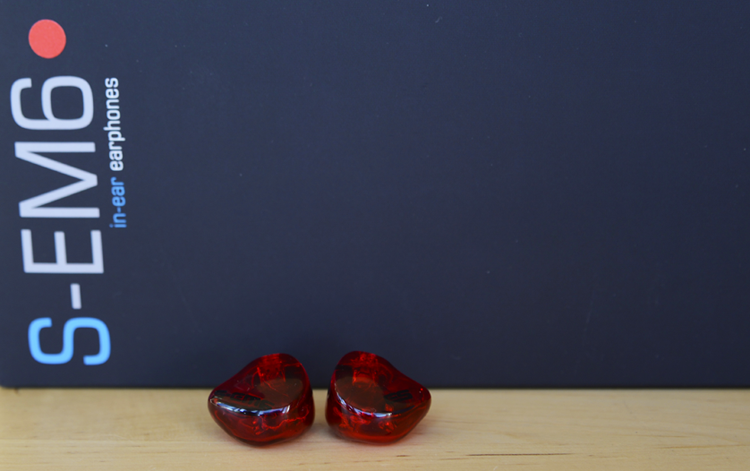Select Comparisons
Dunu DN-2000J
The Dunu and the S-EM6 can be considered polar opposites. In fact, they have so little in common that if you’d stick them in a room together and force a conversation, nothing but an awkward silence would follow. The U-shaped Dunu, with its prominent treble and distant midrange, sounds analytical and bright in comparison. But then again, it has a cleaner background and sounds a great deal more transparent and sparkly with string instruments. The DN-2000J outperforms the S-EM6 with classical music; violins and pianos sound crystal clear and are presented with good micro-detail. But when it comes to the mids, the DN-2000J never stood a chance; the S-EM6’ midrange conveys power and size, while its warmth conveys the emotion the brighter DN-2000j lacks. Compared to the prominent lower and center midrange of the S-EM6, vocals lack depth and can sound hollow with the DN-2000j. Due to the dynamic driver, the DN-2000j’s bass has slightly a nicer texture with a more natural decay, while the S-EM6’ pronounced mid-bass hump has a warmer tone and more overall quantity.
EarSonics Velvet
The Velvet was released shortly after the S-EM6, and indicated the start of a new direction. While both are still immediately recognizable as ES iems and share aspects of the same house sound, the Velvet has a pronounced U-shape with punchy bass, and a lift in the upper midrange and treble. The Velvet has a wide and airy soundstage, with good separation, and its signature seems designed for energetic V-shaped music. The Velvet particularly shines with synthesized treble: for R&B, hip hop, pop or EDM, go with the Velvet. In addition, its airy stage and excellent dynamics make it highly suitable for fast guitars such as punk rock or metal.
While both have excellent bass, the Velvet’s bass has better sub-bass extension and sounds punchier, especially when amped. The tables turn in the midrange, and it’s here that the two are polar opposites. While both share a fun and engaging sound that’s nowhere near neutral, the S-EM6’ midrange is full, warm and engaging. The Velvet’s midrange is sufficient to be labeled allround; but its relative weakness in all the excitement is vocals – they sound distant, and lack the depth and warmth of the S-EM6. For instrument-based music like rock, the S-EM6 is a clear step up from the Velvet; but in absolute terms, their signatures are too different to speak of better or worse – only preference can determine which is the better pick.
Perfect Seal AR6
An MRSP of $950, and 6 BA drives – so far the similarities. The AR6 demonstrates the effect of a different bass tuning on the presentation. The AR6’ sub-bass extends deeper, and hits faster with more control. Its mid-bass is dead neutral, and a great deal lighter on impact than the S-EM6. The neutral mid-bass contributes to the clean presentation, and imaging and separation are its outstanding traits. The S-EM6’ bass on the other hand hits with a great deal more authority, while also providing a great deal more warmth and size to the midrange. The AR6’ center midrange is neutral and thinner compared to the warm and lush S-EM6; while not laidback or recessed, vocals and instruments are smaller in size. The S-EM6’ midrange is a great deal more forward and denser, presenting vocals closer on the stage.
Due to a lift in the upper midrange, the AR6 has a clear tonality with greater transparency; the S-EM6’ upper midrange is more forward and smoother, but less detailed while it sacrifices some of its clarity and transparency due to the warmth. The AR6’ treble is more prominent with a brighter tone, but has a bit less control compared to the S-EM6. A lift in the lower treble provides the AR6 with its unique wide and airy soundstage; while it is only a bit wider than the S-EM6, it is a great deal more airier. The S-EM6’ treble is more laidback, but has slightly better speed. From a holistic perspective, the S-EM6 has a midcentric signature that is warmer, fuller and bassier. The AR6 is clearer and airier, and prides itself on its unique soundstage. Its lower midrange is less prominent, and accordingly notes are leaner in comparison, but its treble is more prominent and detailed.
Empire Ears Apollo
The Apollo represents Empire Ears’ take on a neutral ‘reference’ monitor; and as such its presentation vastly differs from the S-EM6. Apollo’s sub-bass has slightly better extension, but it’s mid-bass is far more neutral and cleaner compared the enhanced and warm mid-bass of the S-EM6. Accordingly, Apollo’s midrange is clearer compared to the warm and prominent lower midrange of the S-EM6. The S-EM6’ midrange is fuller, but Apollo’s is clearer which gives it an advantage in instrument separation – although the S-EM6 doesn’t fall far behind in imaging. The biggest difference is in the upper midrange; with the S-EM6’ being more forward, resulting in a more intimate presentation of vocals, with greater detail in nuances. Apollo seems to have a slight dip there, but in no way can be considered laidback – it’s relatively speaking.
The S-EM6 has thicker notes, and gets the advantage for male vocals, but consider the S-EM6 a specialist in this department. Female vocals sound clearer with the Apollo, but smoother and a again a bit fuller with the S-EM6 – it’s hard to point a winner there. The S-EM6 has its trademark dip in the lower treble, displaying another difference with the Apollo; it is a great deal more airy, and overall there is more space between the instruments compared to the S-EM6’ thicker presentation. In fact, the airiness within the soundstage and clear treble are standout traits of Apollo. Apollo’s stage has a lot of space, and its treble portrays a great balance between smoothness and sparkle, without sounding fatiguing. In comparison, the S-EM6’ treble is more laidback and takes second place to the midrange.
Matchability
With an impedance of 60 ohms, the S-EM6 isn’t particularly efficient and needs sufficient power to be driven. It can still be played at a high enough volume from an ipod or smartphone, but the soundstage collapses; the loss in space can make it prone to congestion, while the presentation loses depth. The S-EM6 scales up with better equipment, although there appears to be a bit of a ceiling effect after a certain point. While iems like the S-EM9 and Zeus keep on improving with every dollar you pile on top of the system, the overall quality of the S-EM6 did not vary greatly between the Chord Mojo, Cowon P1 or Hifiman 901S. This is in part because of the S-EM6’ stubborn character: it is very reluctant to give up any of its warmth or thickness. Where especially Zeus displays a great deal of flexibility and transparency to the source, the overall signature of the S-EM6 remains very consistent.
Both the P1 and Mojo make a good combination, even though their signature is similar to the S-EM6: a midcentric signature with smooth treble and a warmer than neutral background. One might expect the S-EM6 to sound overly warm, but 1+1 = still 1 here. With the P1, the S-EM6 has a slightly more prominent lower midrange, while the Mojo brings out a bit more upper midrange detail, with slightly more air between the instruments and a more 3D feel. But mind you, differences between the two are slight. The 901S brings out a bit more clarity in the midrange, while improving dynamics. But overall, the increase isn’t as incremental as with higher tier iems.
Final Thoughts
For the last two weeks I’ve been listening to the S-EM6 non-stop, without having the urge to reach for more expensive flagship ciems. Which for me is saying a lot, since this is not always the case with iems I’ve had in the past. The S-EM6’s power lies in its holistic presentation: a full and engaging sound with thick notes, that has the capability of drawing you in the music; not in the last part because of the smooth and warm tonality, and excellent midrange. Vocals sound full and captivating, with the flanking instruments in a supportive role. Despite having thick notes, the S-EM6 still has good detail and separation due to the quality of the stage and imaging. The upper midrange dip and smooth treble eliminate sibilance and harshness, and the S-EM6 is very forgiving of bad recordings – while sounding engaging and very musical. The S-EM6 reminds me why I started with this hobby in the first place, to simply sit back and enjoy music.
The moment you hear the S-EM6, it becomes clear there was a purpose behind the design; again, it is a very musical and emotional sounding iem. As the S-EM6 has its own character that strays from neutral, it might not be for everyone. The S-EM6’ defining characteristics are its bass driven ‘big’ sound, warm atmosphere, and lower treble dip. Stubborn as it is, even listening with a very clear and transparent source like the 901S or switching to silver cables won’t affect the lush midrange or warmth of the presentation, although it does bring out more detail in the higher frequencies. The lower treble dip takes the edge off of sharp sounds, and eliminates all sibilance. But in doing so, can attenuate the top end of instrument definition, while some detail can get lost in the warm atmosphere.
As such it will be less appealing to analytical listeners, seeking an approximation of reference-tuned sound. But for fans of a warm and pleasing midrange, and especially fans of vocals, it will deliver in spades. Its thick notes are captivating and engaging, conveying a great sense of power and emotion. So while it might not be the optimal signature for something like classical musical or jazz; for those about to rock – the S-EM6 salutes you!
Technical Specifications
- Sensitivity: 124 db/mW
- Frequency response: 10 Hz – 20 kHz
- Impedance: 60 ohms
- Design: 6 BA drivers (2 low, 2 mid, 2 high), 3-way passive crossover.







